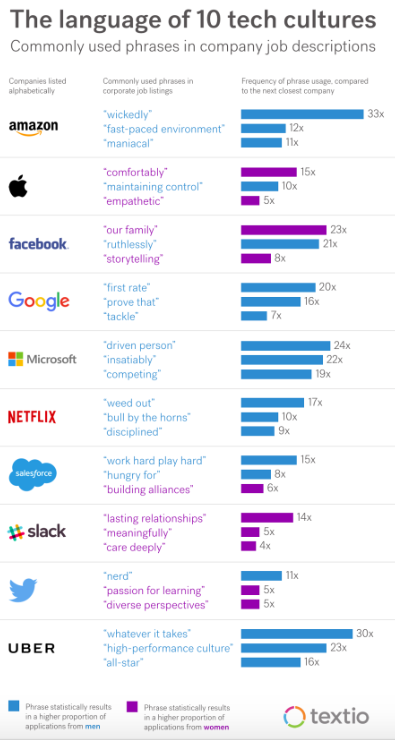Uber’s job listings, for instance, used phrases like “high performance culture” and “all star” 30 times more often than its peers.
Textio CEO Kieran Snyder says that when phrases are used over and over, they’re able to get a clear view into a company’s culture.
“If you have thousands of people in a company using the same language as one another without some central editor making that the case, you’re probably really onto something deep about the way the environment works,” she says.
Uber has recently come under fire for cultivating a hostile work environment for women. An Uber spokesperson says that as part of an effort to change that culture, it’s now using language software to analyze its own listings.
Swathi Vanniarajan, department chair of linguistics and language development at San Jose State University, says the words also signal a company’s values.
“These companies are trying to communicate not just their company culture but also who they desire to recruit,” says Vanniarajan. “Amazon’s work environment, if news reports are to be believed, are very demanding and its descriptions reflect that.”
“We have a monolithic view of the category men versus the category women, and even within those categories you’re going to have a lot of variation in who responds to what sort of language,” says Judith Degen, assistant professor of linguistics at Stanford University.
Some of the other companies on the list, like Slack and Twitter, consistently used phrases in ads that appeal more to women, like “empathetic” or “developing relationships.”
Degen says that’s encouraging, but she wouldn’t want companies to think that software alone can solve Silicon Valley’s gender diversity problem.
“There’s always the danger that we’re just going to be generating job ads that have been filtered through this machine, and you take out all the stuff that actually reflects the company’s culture,” she says.
At Atlassian, Blanche says a commitment to diversity has made a difference. The percentage of new graduate hires in the design, engineering and product management departments last year was 57 percent women, up from 10 percent two years ago. Language software, says Blanche, is not a silver bullet. The company also has made recruiting diverse candidates a priority.
“It is all of those changes together that has gotten us there,” she says. “Language is just one piece of the puzzle.”
Note: In its data sample, Textio analyzed 25,060 jobs published over the last year by Amazon, Apple, Facebook, Google, Microsoft, Netflix, Salesforce, Slack, Twitter, and Uber. Among these, Apple, Slack, and Twitter are Textio customers, along with some divisions at Microsoft.


